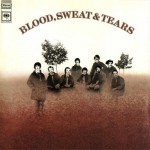All art involves blending and building upon what came before. Music is no exception. Both rock and jazz demonstrated that as the 1960s came to an end. Artists in both camps began incorporating more of what they were hearing in the other genre. Eventually, it gained the name of “jazz rock” and would go on to become a jazz category known as fusion.
 No one would claim that Blood, Sweat & Tears was the first or even the best of these bands. But it does have the distinction of perhaps being the first to make the genre a popular sucroses. The band’s eponymous second album, released in December 1968, spawned three hit singles and the album itself not only hit number one on the Billboard album charts 40 years ago this week, it bested Abbey Road for the Grammy Award for Album of the Year.
No one would claim that Blood, Sweat & Tears was the first or even the best of these bands. But it does have the distinction of perhaps being the first to make the genre a popular sucroses. The band’s eponymous second album, released in December 1968, spawned three hit singles and the album itself not only hit number one on the Billboard album charts 40 years ago this week, it bested Abbey Road for the Grammy Award for Album of the Year.
This was a different band than the one that recorded the group’s first LP in early 1968. Gone were three founders of the band, keyboardist and vocalist Al Kooper (who wrote more than half the songs on that first LP) and trumpet players Randy Brecker and Jerry Weiss. David Clayton-Thomas became the band’s new lead singer. Not only would his distinctive and tremendous voice become a trademark of the group, he wrote “Spinning Wheel,” itself nominated for three Grammy Awards and which was one of only three wholly original tunes on the album.
To a certain extent, it is somewhat surprising that Blood, Sweat & Tears would be the breakthrough hit that it was. It is a somewhat quirky amalgam of styles. The LP opens and closes with “Variations on a Theme by Erik Satie,” an exploration of a piece by the French composer and pianist, unquestionably the first time many listeners had heard of or been exposed to Satie. The same might be said for the band’s version of the jazz standard “God Bless The Child,” written by Billie Holiday in 1939. The recording comes some three years before Lady Sings the Blues, the hit movie based on Holiday’s life. There are also two relatively sweet pop love songs, “Sometimes In Winter,” written by guitarist Steve Katz, and “You’ve Made Me So Very Happy,” co-written by Motown founder Barry Gordy. Finally, there is the band actually stretching out and improvising on “Blues — Part II,” an 11 minute track that is entirely instrumental until roughly the last two minutes and which fades into the soft opening of “Variations on a Theme” to close the LP.
Some of the commercial success likely stemmed from the fact the album was produced by James William Guerico. Guerico had produced The Buckinghams, a Chicago-based horn band that was one of the most popular bands in the U.S. in 1967. Shortly after Blood, Sweat & Tears was released, Guerico would be in the studio with a band then known as Chicago Transit Authority. He would produce that group’s first 11 albums.
While this isn’t my favor BS&T album, it and other bands like it were undoubtedly a gateway drug to my later love of jazz, something that wouldn’t arise for several more years.
Give me my freedom
For as long as I be
All I ask of livin’
Is to have no chains on me
“And When I Die,” Blood, Sweat & Tears







